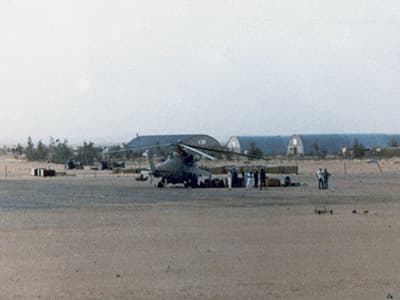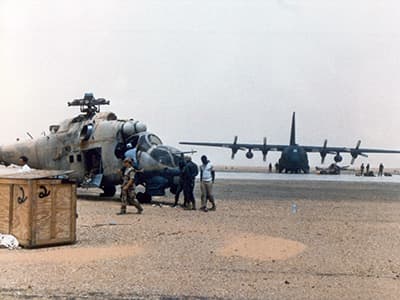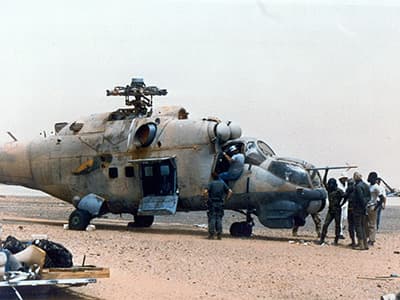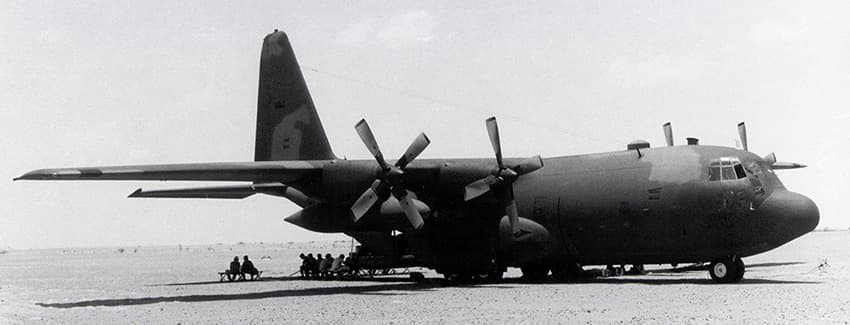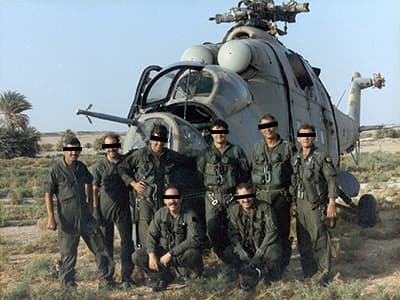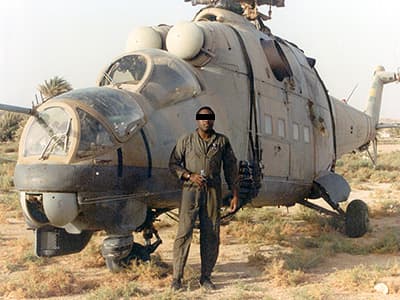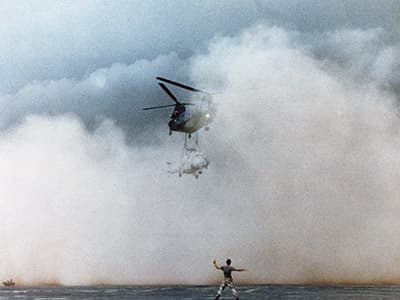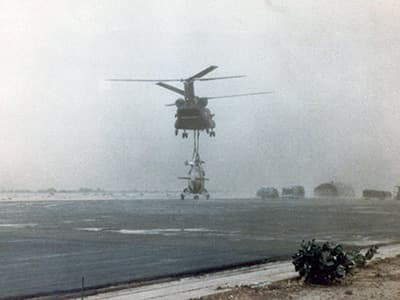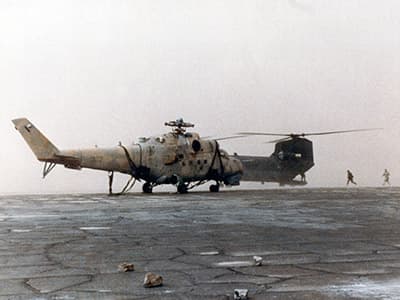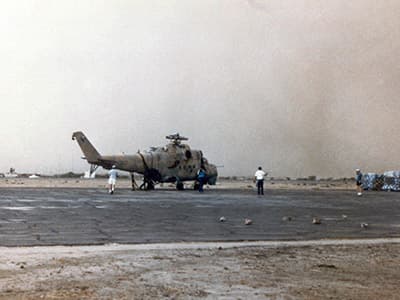ABSTRACT
In 1988, the professionalism of the soldiers of Company E, 160th Special Operations Aviation Regiment stood out during Operation MOUNT HOPE III. The unit received the sensitive mission of securing a key piece of Soviet combat technology, a downed but still-operational Mi-24 Hind attack helicopter, from Chad, but near the precarious Libyan border. The crews and maintenance personnel successfully executed the challenging recovery, which included disassembling, transporting, reassembling, and again dismantling and shipping their MH-47D Chinooks. This mission, performed without incident, both secured a working Hind for evaluation by the U.S. Army and highlighted the capability of Army Special Operations Aviation.
NOTE
IAW USSOCOM sanitization protocol for historical articles on recent operations, pseudonyms are used for majors and below who are still on active duty, unless names have been publicly released for awards/decorations or DoD news release. Pseudonyms are identified with an asterisk (*). The eyes of active ARSOF personnel in photos are blocked out when not covered with dark visors or sunglasses, except when the photos were publicly released by a service or DoD. Source references (end notes) utilize the assigned pseudonym.
TAKEAWAYS
- Securing the Mi-24 Hind allowed the U.S. to examine the capabilities of a key piece of Soviet combat technology.
- In a short timeframe, Company E was able to accomplish the mission of recovering a working Hind from a remote and potentially dangerous location near the Libyan border to a safer location where it could be shipped to the United States.
- The stellar performance of Company E’s soldiers allowed for a successful mission that underscored the unique capabilities of Army special operations aviation.
DOWNLOAD
Just forty-five minutes of flight time from their destination of an airfield at N’Djamena, Chad, the crews of two MH-47D Chinook heavy lift helicopters encountered a critical situation: they were about to be engulfed by a great wall of sand. The Air Mission Commander of the lead aircraft, Major (MAJ) Gary S. Hasselbach*, recalled that he could “almost see [the airfield] when we were swallowed by the sandstorm.”1 Normally, the pilots would simply fly above the storm. On this occasion, doing so was impossible. Sling-loaded below MAJ Hasselbach’s Chinook was a massive Mi-24 ‘Hind’ Russian-made attack helicopter.
For safety, the pilots of the two Chinooks reduced speed and separated their aircraft by a mile. They quickly lost radio contact and sight of one another. Suddenly Hasselbach’s* MH-47D “popped out of the wall of sand. We could see the airfield about twelve miles away.”2 The crew could not spot the other Chinook, but saw the sand rising up to nearly 3,000 feet behind them. Hasselbach* decided to race to the airfield, set the Hind down, and land before the storm once again overtook the aircraft. After completing that action, the other Chinook emerged from the wall. That pilot only had enough time to set down, and, as Hasselbach* related, he “did not even turn into the wind.”3 Once down, the crews sat in their helicopters for the next twenty minutes as sand blasted the airframes. When they finally emerged, grit covered everything. But, they had succeeded in securing their Cold War prize, a working Hind.
This article explains the 1988 MOUNT HOPE III operation to recover a Soviet-made Hind helicopter. It was a critically important early mission for Company E, 160th Special Operations Aviation Group (SOAG), which later became 2nd Battalion, 160th Special Operations Aviation Regiment (SOAR). The recovery in Chad showcased the operational capabilities of the Chinook airframe in an austere environment at a time when the nascent 160th viewed the helicopter primarily as a gasoline hauler for refueling other helicopters.4
The context of the mission was the Cold War (roughly 1947-1991), in which the United States and its allies faced off in a war of ideologies against the Soviet Union and its satellite nations; a contest between Democracy and Communism. In an almost constant state of tension, one of the ways that each side spread their influence was through weapons sales and use of proxies. Libya, then anti-western and armed with Soviet military equipment, put those weapons to use in its territorial dispute with Chad.5
The Toyota War (1986-1987), the last of a series of border clashes that took place from 1978 to 1987, decided which country would control the Aouzou Strip, a 100-kilometer deep section of northern Chad that runs along the Libyan border. Using armed Toyota pickup trucks, or ‘technicals,’ for mobility, Chadian forces soundly defeated the Libyans. Suffering heavy losses, the Libyans abandoned large amounts of equipment as they fled Chad. The material left behind presented the West with a unique opportunity to study Soviet battlefield technology, including the formidable Mi-24 ‘Hind’ attack helicopter.6


Acquiring a Hind had long been a U.S. priority because the military did not fully understand its capabilities and limitations.7 Following months of negotiations, U.S. and Chadian officials reached a settlement that allowed U.S. military forces to recover one of the abandoned helicopters. A previous attempt to recover another Mi-24 in Chad by cutting it up and transporting it by truck failed to deliver an operational platform. The best solution to successfully recover an intact aircraft seemed to be by airlifting it to an airfield where it could be packed and transported to the U.S. The mission fell to Company E, 160th SOAG.
In April 1988, Company E prepared for the operation with a stateside test simulating lifting and flying with a sling-loaded helicopter. The unit disassembled and loaded two MH-47Ds into a U.S. Air Force C-5 Galaxy and transported them to Roswell, New Mexico. To replicate the distance in Chad, the reassembled Chinooks flew to Biggs Army Air Field (AAF), El Paso, Texas. There, the first MH-47D sling loaded six full 500-gallon water blivets to simulate the weight of a Mi-24. Flying at night around White Sands, New Mexico, both helicopters had to twice land and refuel from C-130s staged along the route. Having successfully completed the simulation, Company E was ready when it received the execution order on 21 May 1988.8
Careful preparation did not mean that all went smoothly. Led by Hasselbach*, the advanced party flew to U.S. European Command (USEUCOM) Headquarters in Stuttgart, Germany. As soon as they got off the plane, the USEUCOM J-3 demanded that the party give him a briefing. Hasselbach* recalled, “We looked like crap because we flew all night.”9 During the brief, the colonel in charge of the J-3 interrupted to demand that the 160th perform the mission during daylight hours just like a Regular Army Chinook unit. The advanced party then asked why one of the Chinook units already in Germany could not perform the mission. Receiving no response from the J-3, on the spot they called Major General (MG) Gary E. Luck, the commanding general of the Joint Special Operations Command. MAJ Hasselbach* explained the situation to MG Luck, who in turn asked to speak to the J-3 colonel. After speaking with MG Luck, the colonel said, “proceed with the briefing,” and offered no other resistance to the plan.10 Four days later, the group flew from Paris to N’Djamena, Chad, landing on 31 May. There they made billeting arrangements with the U.S. Embassy for the remainder of the group (a total of 67 soldiers) that would arrive two weeks later.


